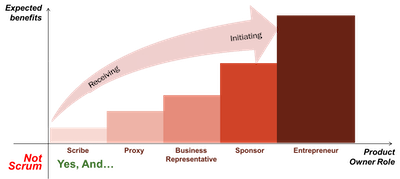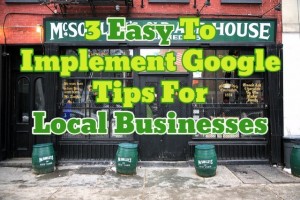— November 13, 2018
The Product Owner role is implemented in organizations in various different ways. The responsibilities and authorities of Product Owners vary across organizations, departments, teams, and Product Owners. This can be explained to some extent because it is a role that people need to grow into. The role requires some specific competencies and a specific mindset. In addition, for many organizations, it is a new and unknown role in which people (typically management) are trying to find the right balance of responsibilities and mandate. Preferably, a Product Owner has a lot of mandate and he or she is the final decision maker for the product. In many organizations, this is not (yet) the case, however.
In order to create clarity about the level of Product Ownership in your organization, we distinguish five types of Product Owners:
- The Scribe
- The Proxy
- The Business Representative
- The Sponsor
- The Entrepreneur

The figure shows these different types of Product Owners visually. In this figure, you’ll see the expected benefits that can be achieved, based on the authorities (or maturity) of the Product Owner. A ‘Scribe’ therefore has few responsibilities and authorities, an ‘Entrepreneur’ has many responsibilities and authorities.
The image shows the growth path of the Product Owner as we often see it at organizations. Product Owners grow in their authorities and herewith, the added value of their role increases for the product, organization, and customers. Having more mature Product Owners will enable organizations to experience more benefits of applying Scrum and value delivery will typically increase for the better. In the following paragraphs, the different types of Product Owners are explained in more detail, and we will discuss how you as a Product Owner can take a step in the authorities that you have.
The Scribe
We often find the Scribe Product Owner role in organizations that are just starting out with Scrum, and/or in organizations that have not completely embraced the Agile mindset (and therefore do not apply Scrum properly). These organizations see the Product Owner primarily as someone who administers the Product Backlog, collects the wishes from the stakeholders and translates them into User Stories for the Development Team. This type of Product Owner often has none to very limited authorities. This Product Owner mainly ensures that the wishes of the stakeholders are written out in understandable language for the Development Team. In organizations where this type of Product Owner is very common, Business Analysts or Requirements Engineers are often appointed as Product Owner. In such situations, the mandate often lies with someone else, such as a steering committee or a Project Management Office (PMO).
The Proxy
Just like the Scribe Product Owner, we often see the Proxy Product Owner (in short: Proxy) in organizations that are in a starting phase with an Agile way-of-working and in adopting the Scrum Framework. The Proxy has some more authorities than the Scribe has. The Proxy, for example, also often gets the authority to make (limited) choices in the ordering of the Product Backlog. However, the vision, the business goals, the desired outcomes/results, and the scope is still being determined by other people, such as a steering committee, project sponsor or business owner. In many organizations, we encounter Proxy Product Owners who used to be in the position of project manager or team lead. These roles or positions typically already have the responsibility of bringing a project to a successful end. Therefore, it seems logical to many organizations to change these peoples’ roles to ‘Product Owner’. However, these Proxy Product Owners are not the final decision-makers. They typically have to ask for approval when changes happen. They have to ask for approval to change priorities. And they have to ask for approval when they want to change the planning, roadmap and Product Backlog.
The Business Representative
The next type of Product Owner is the Business Representative. The Business Representative is typically a representative from the business side of the organization, who knows the business context, market, customers and users well. Therefore, this person typically knows from experience what customers and users would need and/or what they would like to have. This person is typically one of the ‘seniors’ or ‘experts’ in the organization, who has connections to customers and/or users. This type of Product Owner could also be people like process owners or system owners. Although the term Business Representative suggests that this type of Product Owner comes from ‘the business’, this is not necessarily the case. It could also be that someone from the IT department is in the Product Owner role, with the maturity level ‘Business Representative’. Examples of IT-people in this role could be information managers, architects or security experts. These people may have gained a lot of knowledge about the (technical) product, and therefore be suitable Product Owners. To strengthen this concept of having IT Product Owners… remember that Bill Gates and Steve Jobs were excellent Product Owners too, and these guys really were ‘IT-people’.
So, the Business Representative has more authorities than the Proxy. The Business Representative is typically responsible for a part of the product, a system or a (set of) process(ess). Within this system or process, this Product Owner may determine for him- or herself which work will be carried out by the Development Team. The Business Representative is therefore responsible for the Product Backlog and he or she has the authority to manage the Product Backlog by themselves. This is, however, only as long as the desired changes can be done within the budget that was allocated by other people, such as management or a steering committee. The Business Representative does not have an own budget to spend as desired. He or she needs to get approval for budget changes and therefore often still has to deal with a steering committee or manager. The Business Representative also typically has a list of work to be done, projects to perform or goals to achieve, which were defined by someone else.
The Sponsor
In contrast to the Business Representative, the Sponsor has his or her own budget. This is the biggest difference between the ‘Business Representative’ and the ‘Sponsor’. In addition to budget responsibility, the authorities for both types of Product Owners are fairly similar. The Product Owner type ‘Sponsor’ is initially often filled in by business managers, IT managers and customers (in a business-to-business setting) for example. Since Sponsor Product Owners have their own budget, they typically also have more opportunities for up- and downscaling the Development Team. This doesn’t mean that you should add or subtract people per Sprint! It could be, however, that due to the enormous success of the product, the Product Owner would like to scale up to a second or a third team. By having this flexibility and authority these ‘Sponsors’ can, therefore, accelerate and delay developments much more, and therefore they have a greater impact on the return on investment and total cost of ownership of the product. Besides the budget authority, Sponsor Product Owners also have a bigger say in ‘what’ needs to be done. He or she is allowed to define the work to be done, the projects to perform or business goals to achieve.
The Entrepreneur
The last type of Product Owner is called the ‘Entrepreneur’. In practice, we also refer to this role as the ‘mini-CEO’. This level of Product Ownership is what we ultimately want to achieve in organizations. This type of Product Owner can achieve the most impact for customers, users and the organization by far. The Entrepreneur Product Owner takes full responsibility for the product and also has full authority over the product. The Entrepreneur Product Owner is someone with a strong vision on the market, customers and the product. It is someone with passion for the product and is someone with strong leadership and communication skills. Entrepreneur Product Owners are ultimately responsible for the product and are therefore profit & loss responsible. Besides product development, they are also responsible for maintenance, operations, marketing, legal aspects and sales. That is why we typically refer to this level as ‘mini-CEO’. It is a Product Owner who has his or her own ‘mini-company’ (which could be a mini-company within a large enterprise).
Growing responsibilities and authorities
So there are five types of Product Owners, each having their own focus, key responsibilities and authorities. With this growth model you can make an estimation for yourself which type of Product Owner you are, or which types of Product Owners you find in your organization. Remember that the (hierarchical) function within the organization only partially determines which type of Product Owner a person is. If a Product Owner used to be in a management function, he or she probably has some more authorities already. This may help Product Owners to grow faster through the maturity model, but it is not a prerequisite to be or to have been a manager! The authorities a Product Owner has are not only determined by their (previous) function. The authorities are mainly determined by the way you act. By the way the person behaves. In our experience, authorities aren’t given away ‘for free’. Getting more authorities needs to be earned. And the way you earn more authorities is by taking more responsibility and showing ownership.
But how do you take on more responsibilities as a Product Owner? Well, actually that is quite simple… You increase your responsibilities by taking more ownership and responsibility for the success of the product, step by step. For example, develop the product vision and actively promote it amongst your team, stakeholders and management. Actively collaborate with your key stakeholders. Show how you and your team are adding value for customers and users. Make value measurable. And also have a clear view on the costs. Create transparency on these topics and show that you are taking responsibility for the product. Be proactive and do not wait until someone does it for you. So, take initiative. With this you will create more room for yourself to decide things, and thus get more authorities. Successful Product Owners that we have met take responsibility. In many cases, these Product Owners started out as Scribes or Proxy’s. Many of them have developed into Sponsors or Entrepreneurs.
The term ‘Product Owner’ isn’t just made up, because the creators of Scrum ‘needed a name’. The name of this role actually contains the word ‘owner’. So the role is about ‘owning’ the product and it’s about taking the responsibilities that come with owning a product. Therefore, ownership is exactly what you have to display to your stakeholders. This is not just about things like the product vision, Product Backlog and financial aspects. It’s about your attitude, about your mindset and behaviors. So it may help to regularly reflect. Look yourself in the eye. Have you really done everything you could to improve the product? Are any setbacks caused by others, or could you have done something in a different way? Take ownership!
I hope this blog helps you to gain some insights into the growth path for Product Owners and some steps you could take to increase your responsibilities and authorities as a Product Owner. There is of course much more you could do, but I’m also curious about your own experiences! What type of Product Owner are you? Which steps did you take to grow? What are the next steps for you as a Product Owner?
Thank you for reading!
Business & Finance Articles on Business 2 Community
(155)





